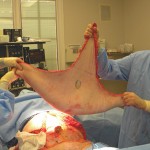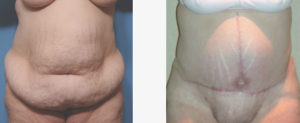The traditional tummy tuck (abdominoplasty) is primarily what I call a frontal approach where skin and fat is removed from the lower abdomen. The skin cutout is done horizontally in the shape of a football. Often times, liposuction is also performed on the sides around the waistline to get more of a 270 degree result. When the skin excess is not large, this is a perfectly fine approach and will immensely satisfy the vast majority of people who seek abdominal contouring.
When the amount of abdominal skin increases, however, the dimensions of the skin problem change. Redundant skin and fat is present not only in the horizontal direction but in the vertical dimension as well. Such abdominal problems exist in the larger abdominal pannus patient (skin overhang onto the thighs) and in the extreme weight loss patient. (greater than 100 lbs.)
If this additional dimension is not taken into consideration during the planning, patients may be disappointed with the result at the sides of the waistline. They may wonder why the side of the waistline does look as flat or as contoured as the front. Herein enters the concept of the extended tummy tuck, also known as the anchor tummy tuck or the fleur-de-lis tummy tuck.


In my Indianapolis plastic surgery practice, I have noted that most patients with a lot of excess abdominal skin opt for the most skin removal and the best abdominal contour result. My general approach to the consideration of incisional scarring in non-hidden areas is…if you have to think about whether the scar is worth it…don’t do it. If the answer is an immediate yes and one could care less about the scar (compared to the existing problem), then the scar is not very likely to be a regrettable concern after surgery.
Dr. Barry Eppley
Indianapolis, Indiana


